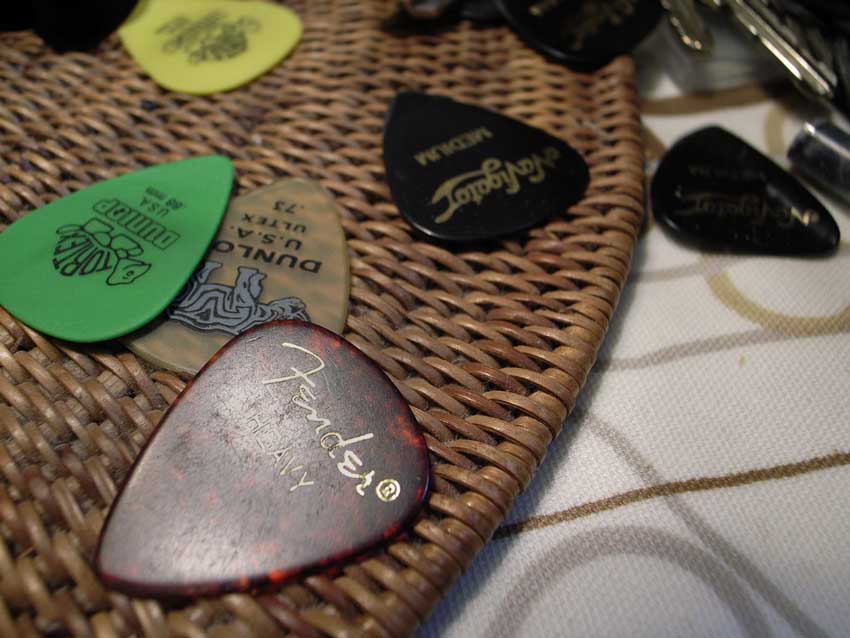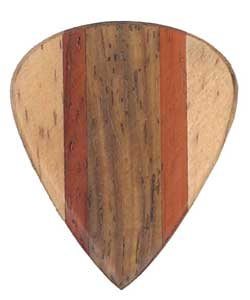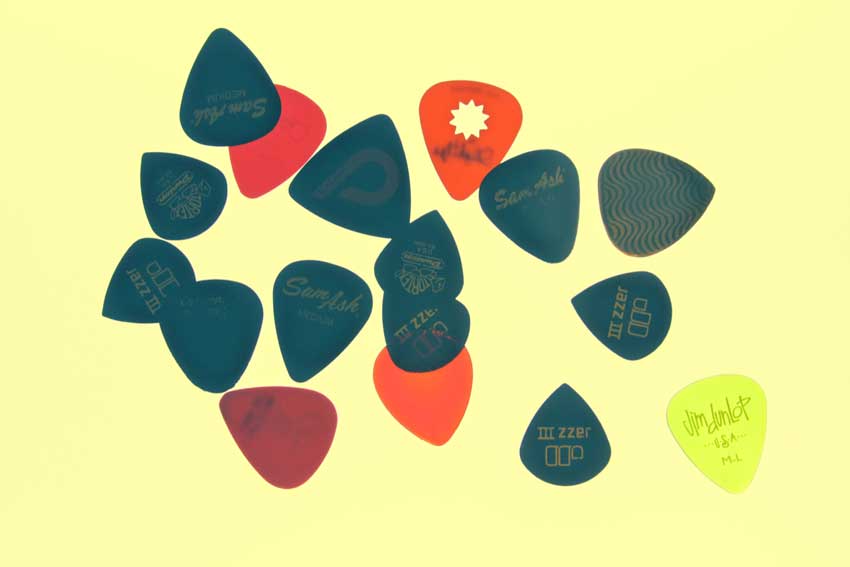The guitar pick – that small unassuming element of music that is often disregarded entirely. What a bummer too, because for what amounts to mere cents, selecting the right pick for the job can drastically alter your tone and playing feel in surprisingly crucial ways. Most guitarists I have known over the years have had no rhyme or reason as to why they first chose or still play certain picks.
What’s more, a lot of musicians will find a pick they bond with and then use it across the board in all musical applications. While pick monogamy is completely normal, reaching for a different pick for each musical need is quick, cheap, and takes almost no effort, allowing you to focus your energy where it should be: your music. What follows are a few basic guidelines to be aware of when selecting your pick from the wide spectrum of plectrums available.
Thickness
A pick’s general thickness is an important factor to consider – we all know the feeling when someone lets us borrow their pick and it’s drastically different than the gauge you are used to playing. It can feel as if you are playing a different instrument, and in many ways, that’s true. Different picks react completely differently to guitar strings in a few basic ways. Thin picks (anything generally .60 gauge or thinner) are great for a little bit of forgiveness when playing, which is why beginners and guitarists who generally love to strum chords gravitate towards them. The pick bends when making
contact with the strings and makes for a fluid follow-through. It also gives an airy quality to the tone with more enhanced treble frequencies because of the way the pick’s surface glides across the strings, rather than through them like when using heavier gauge picks. However, using thin picks can be more difficult when your music calls for single-note lines – thin picks can be harder to control when accuracy is needed.

An array of pick types and gauges.
This brings us to the pros of using thicker picks. A larger pick, such as a .88 or .96 gauge, is not quite so comfortable for things like strumming, because it tends to feel rigid against the strings. However, that same drawback is also its greatest strength: stability. I choose to reach for picks on the heavier end, like Dunlop Tortex .88 or 1.0 mm picks to achieve wonderful clarity for my single-note lines. The pick attack is crystal clear and gives a noticeably “fatter” tone when soloing is needed. The lack of “give” in the pick also enhances accuracy and allows you to focus your pick with high degree of detail, which is great for things like arpeggios or fast, tremolo-picked lines. Bass guitar can be enhanced with extra-thick picks for added body, while thin picks can give a crisper tone if needed. While making the move from thin to thick picks and vice versa can be difficult, it is a good idea to focus on using both ends of the spectrum in your playing to become familiar with how to effectively use each of them, as well as recognize what each pick is essentially doing to your tone.
Material
The material of your pick makes a big difference in your tone as well, but it can be difficult to navigate the many choices available. Most any pick you find will usually be made of some sort of plastic, and it’s been this way for almost 100 years. While there are many more types and materials than are covered here, like shell, glass, or stone, these types of picks are the ones found most often:
- Celluloid – the ones we all know and love, Fender Classic picks are great examples of a celluloid pick. This material is very pliable and tends to impart a snappy, bright tone. A classic choice for playing acoustic guitar, but works equally well for electric guitar. Their pliability can make these picks more susceptible to breakage if used aggressively, so keep a few spares around if you are the heavy-handed type.
- Delrin (acetal) – my personal favorite, the best known of this material type is the Dunlop Tortex pick line. They are much more durable, rarely break, and have a slightly coarser feel to them, which helps you keep a solid grip on your pick even under the sweatiest conditions. The tone is a little darker than Celluloid, with enhanced body and character. On acoustic guitar, it allows you to tame the harshness in the upper register than some acoustics can have.
- Nylon – this material is another long-standing favorite. These are generally easy to grip, and are popular in thin varieties. A great example are the Dunlop Nylon Jazz III picks. The material allows super-thin picks to be made for easy strumming.
- Delrex – this is the material of the popular Dunlop Gator Grip picks, where maximum grip is needed. The material is also nice when used in extra thick gauges (as high as 2.0 mm or more).
- Metal – these picks are great if extra bright attack is warranted, but can make some instruments sound a little harsh, especially with acoustic applications. This isn’t a hard-and-fast rule though, so experiment with your equipment.
- Wood – this material is unique in that it imparts almost no pick attack at all when used. Some users describe it as being flat-sounding, and in some cases “dead.” This can be a pro or a con depending on application.
Shape
The actual shape of your pick will have a great deal of influence on the comfort of your playing experience. There are many varieties found, but generally speaking, most will be the standard triangle shape. Other varieties that are worth exploring, include the teardrop shape, like the Dunlop Jazz picks mentioned earlier, that have a smaller overall shape with a more defined point. Articulation is huge with a pick like that, which is why jazz players, and shred metal players who need maximum precision gravitate towards them. Some players dislike the smaller shape though, finding that it makes it much harder to hold the pick and prevent dropping it. I however, have grown to like playing them as an alternative option, and I love how the unconventional tone they bring to acoustic guitars. Other shapes include large triangles, with extra grip surface, and truly unique options like sharkfin shapes too.
Pick your Pick
While this guide barely grazes the surface of the world of picks, the good news is that your options are nearly limitless. See what fits the right way in your own hands and as always, experimentation is key. If you feel your guitar, amp, or acoustic aren’t sounding the way you want them to, reach for a different pick and see if it changes your experience for the better.






Leave a Reply